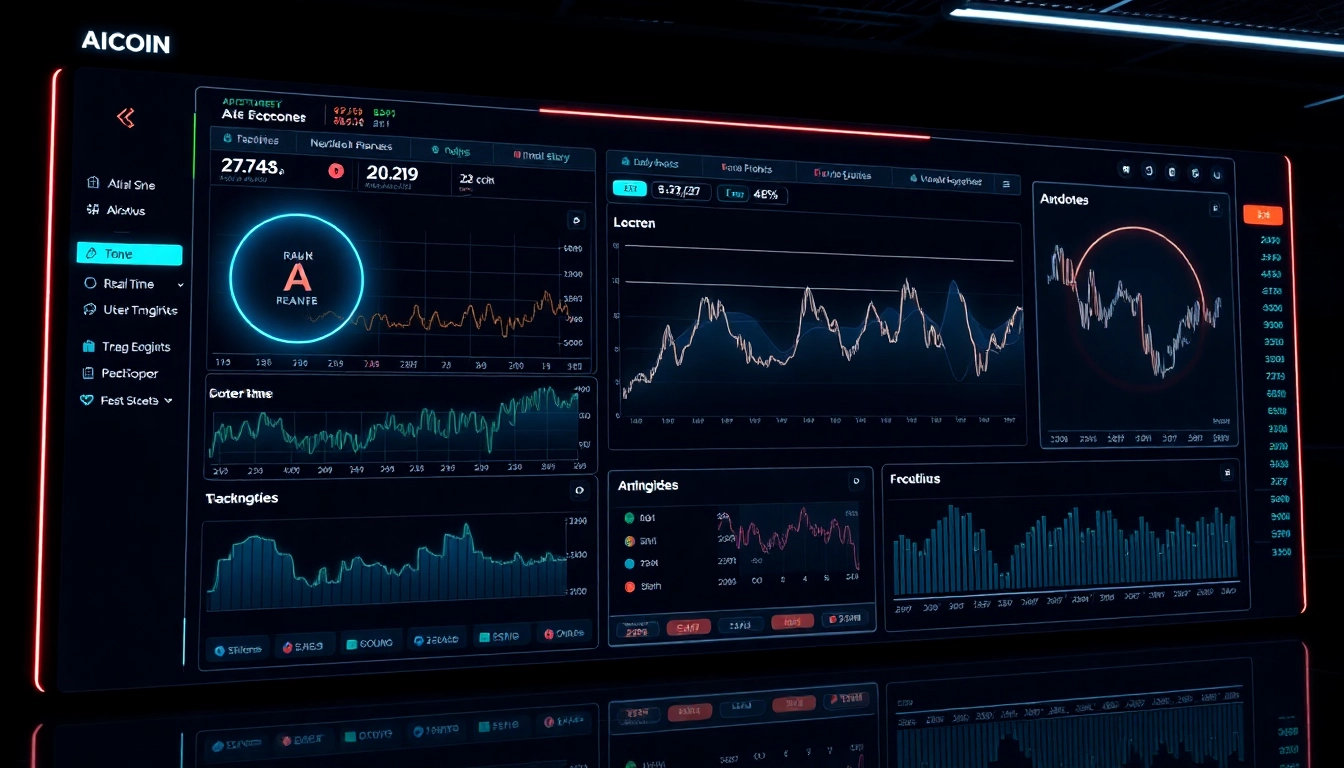Current Trends and Insights in the Cryptocurrency Market Landscape
In an ever-evolving global economic environment, the cryptocurrency market continues to command significant attention from investors, regulators, and industry leaders alike. Recent developments highlight a landscape characterized by nuanced fluctuations, regulatory shifts, and technological innovations that shape the future trajectory of digital currencies. For those seeking clarity amid market volatility, understanding the latest trends and insights is crucial. To gain a comprehensive overview of this dynamic sector, explore our detailed Cryptocurrency Market News.
Recent Trends Shaping Digital Currency Markets
Over the past quarter, several key trends have defined the movement within the cryptocurrency sphere. Despite mixed performance among top cryptocurrencies, notable milestones such as new all-time highs for certain assets, rising institutional interest, and technological advancements are indicative of a maturing market. For instance, gold’s record-breaking surge past $3,500 an ounce mirrors broader investor interest in alternative assets during macroeconomic uncertainties, which often correlates with crypto assets as a hedge.
Additionally, the emergence of niche digital assets and altcoins continues to diversify investment options. Market cap metrics reveal a shift towards smaller, high-potential tokens that cater to specific applications—ranging from DeFi protocols to utility tokens. Such diversification enhances liquidity and growth opportunities but also injects complexity, necessitating thorough due diligence and awareness of market volatility.
This period also witnesses increased integration of artificial intelligence and machine learning tools within trading platforms, enhancing market analysis and predictive capabilities. Leading exchanges and trading firms now leverage AI-powered R&D, promising smarter trading decisions and improved risk management strategies. Staying updated with these shifts is vital for traders aiming to capitalize on emerging opportunities.
Impact of Global Economic Factors on Cryptocurrency Prices
The cryptocurrency market does not operate in isolation; instead, it is intricately linked to broader economic trends. Recent data suggest that movements in traditional assets, such as equities and commodities, influence crypto prices significantly. For example, the drop in the US dollar after U.S. labor data releases and rate cut hopes collectively buoyed Bitcoin and Ether, underscoring their role as alternative stores of value during currency fluctuations.
Moreover, geopolitical tensions, such as trade disputes and sanctions, often propel investors toward decentralization, further fueling demand for digital assets. The recent pause in US-China tariffs, combined with China’s weak manufacturing data diminishing iron ore futures, reflects a cautious economic outlook that can encourage dollar strength and influence crypto trading strategies.
Inflation data also plays a pivotal role. US inflation figures, particularly, guide monetary policy expectations, directly impacting investment flows into cryptocurrencies. An environment of rising inflation often triggers increased interest in hard assets like gold and Bitcoin, which are perceived as inflation hedges.
Market Volatility and Investor Sentiment
Market volatility remains a defining characteristic of cryptocurrencies. The past months have seen sharp swings—such as Coinbase’s Q2 revenue dips amid SEC scrutiny, and NFT market caps dropping by over $1.2 billion as Ether rallies slow down—highlighting the fragile sentiment in the space. These fluctuations are frequently driven by regulatory uncertainties, macroeconomic news, and technological developments.
Investor sentiment oscillates between optimism and caution, often intensified by notable events like the Trump-Fed feud, which added to the dollar’s recent gains and influenced crypto trading patterns. For example, the sharp decline in the NFT market cap indicates a shift in retail investor enthusiasm, prompting a reassessment of risk exposure.
Further, trading behaviors driven by short-term speculation can exacerbate volatility, underscoring the importance for traders to adopt disciplined strategies. Technical analysis indicators, such as 200-week trendlines, provide valuable signals—Bitcoin’s potential to go ‘full bull’ hinges on these long-term supports—highlighting the necessity for both technical and fundamental insights when navigating crypto markets.
Key Cryptocurrencies to Watch in 2024
Bitcoin and Ethereum: Market Leaders and Future Predictions
As the flagship cryptocurrencies, Bitcoin and Ethereum continue to define overall market health. Bitcoin’s resilience, supported by its 200-week trendline, is a critical factor. Analysts suggest that if this support holds, a full bullish cycle could ensue, potentially pushing prices into new all-time highs. Ethereum’s leading role in the expanding DeFi and NFT ecosystems further cements its significance; its scalability upgrades and momentum in smart contract adoption are promising signs for bullish continuation.
Emerging Altcoins and Niche Digital Assets
Beyond Bitcoin and Ethereum, emerging altcoins—particularly those integrating DeFi innovations, Layer 2 solutions, or addressing specific industry needs—are gaining attention. Tokens like Solana, Binance Coin, and newer entries tailored for enterprise solutions are expanding the market landscape. Investors are advised to scrutinize liquidity, utility, and project fundamentals before allocating capital.
Market Cap Trends and Liquidity Insights
Market capitalization metrics reveal shifts in investor interest and liquidity distribution. As some assets stabilize or decline, others emerge with rapid growth, often driven by technological progress or strategic partnerships. Liquidity levels, crucial for executing large trades without adverse price impact, vary across exchanges and tokens, emphasizing the importance of platform choice and order management.
Regulatory Developments and Their Influence on Cryptocurrency Market News
Global Regulatory Landscape and Future Outlook
Regulation remains a double-edged sword—offering clarity and security while potentially limiting growth. Recent warnings from authorities like the Bank of England regarding Libra’s UK launch exemplify cautious approaches. Conversely, some jurisdictions are progressing toward comprehensive frameworks that encourage innovation, such as Singapore’s relatively permissive stance.
Government Crackdowns versus Adoption Initiatives
Instances such as US SEC actions against crypto trading platforms or potential bans contrast with progressive adoption efforts—like institutional investments in Bitcoin and corporate Treasury allocations. Governments are increasingly engaging in defining legal parameters, fostering mass adoption while ensuring consumer protection.
Legal Challenges Impacting Market Stability
Legal uncertainties, including ongoing SEC investigations or court rulings—such as the Delhi HC’s stance on crowdfunding—create episodes of market instability. Nonetheless, steady regulatory engagement can help stabilize prices and foster trust. Traders should monitor policy announcements closely, as legal adaptations directly influence market sentiment and asset valuations.
Investment Strategies and Risks in Cryptocurrency Markets
Analyzing Risk Management Techniques
Effective risk management involves diversification—spreading investments across assets like Bitcoin, Ether, and select altcoins—and employing stop-loss orders. Understanding market correlations, like gold’s record highs amidst volatility, adds an extra layer of protection. Regular portfolio rebalancing aligned with market conditions mitigates exposure to sudden downturns.
Technical vs. Fundamental Analysis for Crypto Trading
Successful traders leverage both approaches. Technical analysis, using trendlines and volume indicators, guides entry and exit points. Fundamental analysis, focused on project reliability, technological advancements, and macroeconomic impacts, ensures investments are not solely driven by speculation. For example, Ethereum’s upgrades or regulatory news can significantly influence long-term valuation.
Portfolio Diversification and Long-term Planning
Long-term investors should consider staking, yield farming, or holding diversified baskets that include digital, physical assets like gold, and fiat currencies. Additionally, understanding the evolving nature of blockchain technology—such as breakthroughs in AI-powered R&D—can inform future-proof investment plans.
Future Outlook and Innovations in Cryptocurrency Market News
Emerging Technologies and Blockchain Developments
Blockchain innovations, including Layer 2 solutions, interoperability protocols, and AI-enhanced smart contracts, promise to improve scalability, security, and user experience. These advancements are poised to foster broader adoption, especially in enterprise contexts and financial services.
Integration with Traditional Financial Systems
The gradual integration of cryptocurrencies into traditional banking and payment systems—highlighted by collaborations with major institutions—will likely drive increased liquidity and legitimacy. Central Bank Digital Currencies (CBDCs) and regulatory clarity will further facilitate this transition.
Predictions for Market Growth and Sustainability
Analysts project that digital assets could capture a significant share of global assets under management, especially as environmental, social, and governance (ESG) criteria influence investment decisions. Sustainable blockchain initiatives, coupled with institutional adoption, point toward a mature, resilient market capable of weathering macroeconomic shocks.



